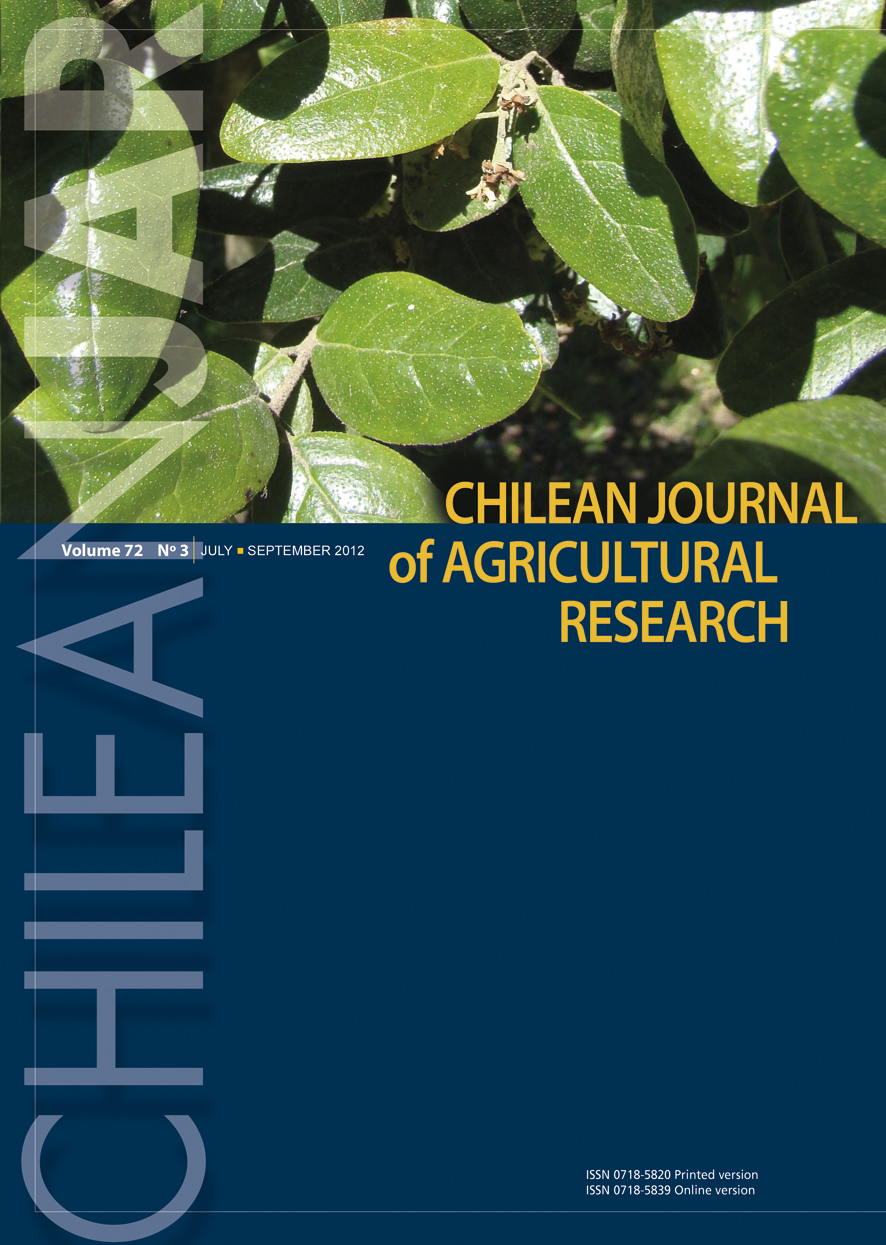
|
Chilean Journal of Agricultural Research
Instituto de Investigaciones Agropecuarias, INIA
ISSN: 0718-5820
EISSN: 0718-5820
Vol. 68, No. 3, 2008, pp. 217-227
|
 Bioline Code: cj08021
Bioline Code: cj08021
Full paper language: English
Document type: Research Article
Document available free of charge
|
|
|
Chilean Journal of Agricultural Research, Vol. 68, No. 3, 2008, pp. 217-227
| en |
Effect Of Harvest Time And L-cysteine As An antioxidant On Flesh Browning Of Fresh-Cut Cherimoya ( Annonacherimola cherimola  Mill.) Mill.)
Campos-Vargas, Reinaldo; Defilippi, Bruno G.; Romero, Paula Q.; Valdés, Héctor G.; Robledo, Paula M. & Prieto, Humberto E.
Abstract
Browning development is the most important factor limiting the quality of fresh-cut cherimoya ( Annonacherimola cherimola

Mill.). However, there is little information available about its causes and methods of control. The effectiveness of L-cysteine (0.125, 0.25 and 0.5%) in fresh-cut cherimoya harvested on two occasions (October and November) and stored for 6 and 12 days at 0 °C was studied. In order to understand the biological basis of browning, polyphenol oxidase (PPO) enzyme activity and total phenolic content in fresh-cut pieces were measured. Quality measurements and sensory analysis indicated that 0.5% L-cysteine was somewhat effective in reducing browning development, without affecting other quality attributes. In terms of physiological parameters, PPO activity did not show differences between mature (at harvest) and ripe fruit (at processing) in both harvest times, but cherimoya fruits picked in November presented lower PPO activity than fruit from October. In general, PPO activity and total phenolic content of L-cysteine treated fruits did not show consistent differences with untreated fruit at 6 or 12 days at 0 °C. PPO activity analyses demonstrated that PPO activity was higher in the outer part of cherimoya flesh compared to the middle or inner sector. These results would support the possibility of using L-cysteine as a postharvest treatment to reduce browning development in fresh-cut cherimoya.
antioxidants, Annona cherimola, polyphenol oxidase, phenolics, sensorial evaluation.
|
| |
| es |
Efecto del momento de cosecha y L-cisteína como un antioxidante en el pardeamiento de pulpa de chirimoya ( Annonacherimola cherimola  Mill.) precortada Mill.) precortada
Campos-Vargas, Reinaldo; Defilippi, Bruno G.; Romero, Paula Q.; Valdés, Héctor G.; Robledo, Paula M. & Prieto, Humberto E.
Resumen
El desarrollo de pardeamiento es uno de los factores limitantes en la calidad de chirimoya ( Annonacherimola cherimola

Mill.) precortada (fresh-cut). No obstante, existe poca información disponible en relación a sus causas y métodos de control en esta fruta. Se estudió la efectividad de L-cisteína (0,125; 0,25 y 0,5%) en chirimoya precortada cosechada en dos oportunidades (octubre y noviembre) y almacenada por 6 y 12 días a 0 ˚C. Con el objetivo de conocer las bases biológicas del pardeamiento, se estudió la actividad de polifenol oxidasa (PPO) y contenido de fenólicos totales en piezas resultantes del precortado. Las mediciones de calidad y análisis sensorial indicaron que el tratamiento 0,5% L-cisteína fue el más efectivo en reducir el desarrollo de pardeamiento sin afectar otros atributos de calidad. En términos de parámetros fisiológicos, la actividad de PPO no mostró diferencias entre frutos inmaduros (a la cosecha) y maduros (al procesamiento) en ambas cosechas. Sin embargo, chirimoyas cosechadas en noviembre presentaron niveles de actividad de PPO menores que en octubre. En general, la actividad de PPO y contenido total de fenoles de frutos tratados con L-cisteína no presentaron diferencias significativas con respecto a frutos no tratados después de 6 ó 12 días a 0 ˚C. Los análisis de la actividad de PPO demostraron que ésta fue más alta en la parte externa de la pulpa que en el sector medio o interno. Estos resultados respaldarían la posibilidad de usar L-cisteína como un tratamiento de poscosecha para reducir el desarrollo de pardeamiento en chirimoya destinada a precortado.
antioxidantes, Annona cherimola, polifenol oxidasa, fenólicos, evaluación sensorial.
|
| |
© Copyright 2008 - Instituto de Investigaciones Agropecuarias, INIA (Chile).
Alternative site location: http://www.inia.cl
|
|
